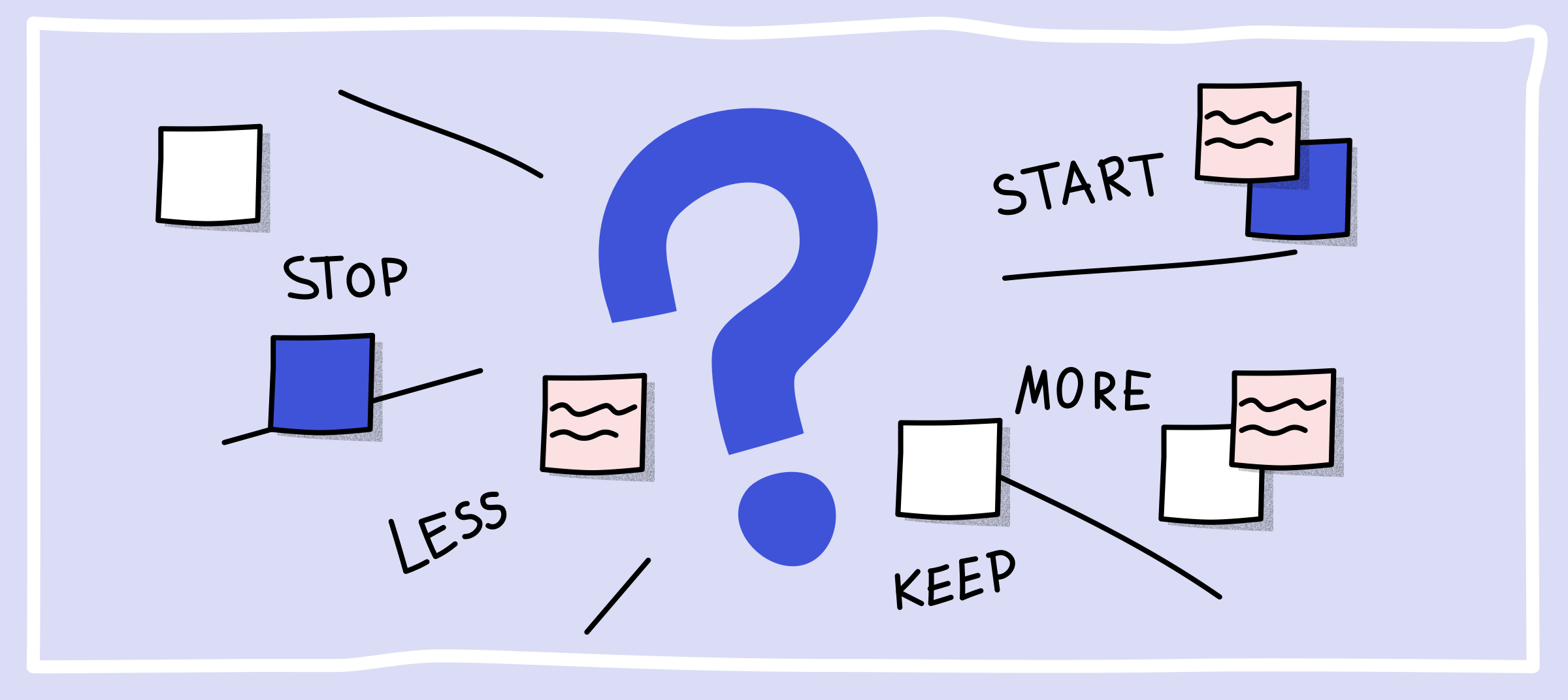A complete guide to run your first sprint retrospective
Sprint Retrospective is one of the most prominent events to radiate these values. It means achieving continuous improvement by constantly learning from our experience. Sprint Retrospective is the last Scrum event within a Sprint. During this event entire Scrum Team- Scrum Master, Product Owner & Development Team inspects the Sprint and decides how to improve the next Sprint.
Today we will talk about how to structure a good Retrospective. And where to look for ideas to run engaging Retrospectives both in-person and remotely.

1. Set the stage
Start with an overview of what’s coming so everyone knows what to expect: the purpose, the focus, the agenda, and the time box. After the introduction, create an atmosphere where people feel comfortable discussing issues. As per the Scrum Guide: “The Scrum Master ensures that the meeting is positive and productive.”
Retrospective duration
For a Sprint of one month, a Retrospective takes a maximum of three hours. And usually, for a Sprint of two weeks, it takes from one to one and a half hours.
Actions from past retrospectives
Next, review the improvements or experiments from the past Retrospective. Here is when we can spot probably the main difference between a Scrum Retrospective and a Postmortem. The first one is like a series, each new episode starts with a short reminder “In the last episode of the Sprint Retrospective…”, where we review the actions from the past Retro. The Postmortem is like a sequel or even a new movie altogether. They might have something in common with the previous ones but sometimes they are just one-off episodes, without any connection between each other. We’d rather they didn’t make it into a series.
Warm-up, a quick check-in
After reviewing the actions and a reminder about the last Retro, it’s time for a quick check-in. Esther and Linda explain that if you don’t make sure everyone speaks at the beginning, the participation in the whole event can decrease. For that need an ice-breaker. For a meeting in person it is nice to make the team move to get energized: stand up, walk around, ask how it’s going. When in remote, it still can be fun.
2. Gather data
Gathering data creates a shared picture of what happened. The team should get different perspectives on the events during the Sprint. It’s impossible that everyone knows and sees everything and even harder in remote times. Start with the hard data: events like changes in the team or milestones, metrics like velocity, throughput, and so forth. Encourage people to add to the picture. You can create a timeline of all the events. Then ask the team to interpret the data and comment on it.
Feelings and emotions
Facts and feelings go hand in hand. Feelings tell what’s important to people about the facts and the team.
Esther and Linda explain:
“Creating a structured way for people to talk about feelings makes it more comfortable to raise topics that have an emotional charge. When people avoid emotional content, it doesn’t go away; it goes underground and saps energy and motivation.”
You can list some emotions like “happy”, “sad”, “satisfied”, “frustrated” etc. and ask people to add them to the different stages of the timeline created. This way the team can see which events caused certain feelings in their fellow teammates. With Swift Board, team memebers can express their feelings under each work item discussed.
3. Generate insights
Now that we have gathered data, we want to make sense of it. After seeing the big picture, let the team vote on the most important items. This is a built-in feature within Swift Board BTW. Also, this is where we consider different conditions and interactions and their effect on the team’s performance and collaboration. What helped the team succeed and what brought them down.
There are a few popular templates for this part that can help you in the beginning: the 3Ls “Liked, Learned, and Lacked” or the “Start, Stop, Continue. These templates are available as a starting point when you create a session on Swift Board:
4. Decide your action items
Once your teammates vote on the items that are most urgent to them, you can click on "sort cards by votes" within the board to rank the notes for easier triaging.
Then plan to identify action items to take in the next Sprint based on the votes. Define the owners of the action items. In a self-organized team, the team must implement the improvements to their day-to-day work. So, make sure the actions make it to the Sprint Backlog for the next Sprint and each item has an owner assigned to it.
5. Close the Retrospective
When the actions are clear and their owners identified, it’s time to close the Retrospective. Do it decisively. And thank everyone for their participation. At the very end perform a quick Retro of the Retro. Plus-Delta activity provides a quick way to gather feedback at the end of an exercise or meeting. Pluses represent what went well and should be continued and the deltas, represent what the team would recommend changing for future meetings. This will help you adjust your Retrospectives and improve your facilitation skills.
The desired outcome of a Retrospective
The desired outcome of a Retrospective is a change in behavior, process, or collaboration that will help the team improve. As per the Scrum Guide:
By the end of the Sprint Retrospective, the Scrum Team should have identified improvements that it will implement in the next Sprint. Implementing these improvements in the next Sprint is the adaptation to the inspection of the Scrum Team itself.
